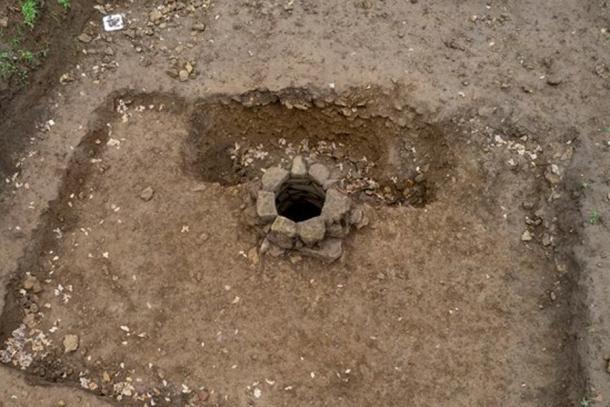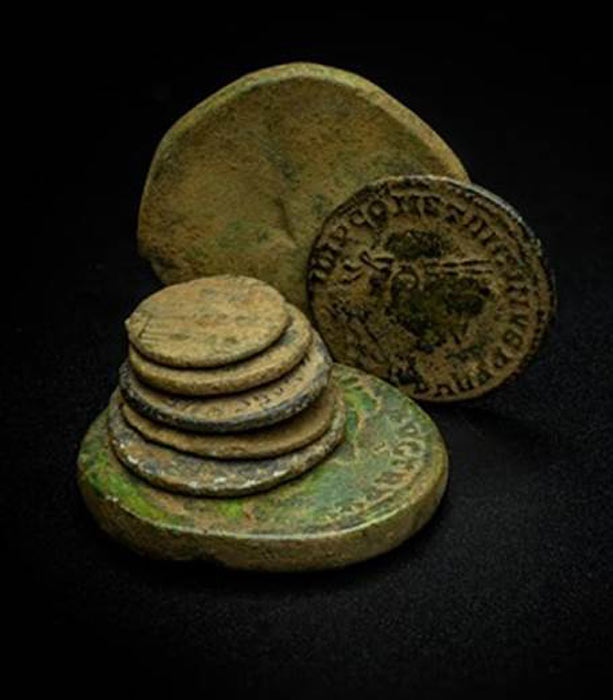
Artifact-Rich Ancient Roman Village Unearthed By UK Archaeologists
Archaeologists employed to search along the pathway of England’s new high speed 2 (HS2) railway line have unearthed an impressive bounty of artifacts, ruins, and other remnants of past cultures at multiple locations. Over the past year, a large team of 80 archaeologists from the private contractor MOLA Headland Infrastructure have been busy excavating an intriguing Iron Age site near the village of Chipping Warden in south Northamptonshire (central England), which is proving to be one of the most productive sites uncovered during the ongoing HS2 explorations.
The site known as Blackgrounds (named after the area’s rich dark soil) reached its peak of prominence as a wealthy Roman market and trading town in the fourth century AD. Digging through the remains of the ancient settlement, archaeologists have found ample evidence to show the village was once a prosperous and active place.
People have known that a Roman village once stood at the Blackgrounds site since the 18th century. But only now have archaeologists finally plunged deeply into the earth to uncover the secrets the buried village has been holding for so long.

The HS2 diggers have found more than one well at the Roman village site at Blackgrounds, indicating just how big this ancient Roman trading center was. (HS2)
A Fourth Century Roman Trading Village in the Heart of England
Evidence indicates that the Chipping Warden Roman village was settled long before the Romans actually arrived on English soil. The original settlers arrived at Blackgrounds around 400 BC, and for the next few hundred years the village remained sleepy and small. Things only changed in the fourth century AD, when the Romans began to dramatically expand the site with new building projects.
- New Date for Chedworth Roman Villa Mosaic Changes English History
- Romanitas in Early Medieval Wales: The Evidence of Latin Standing Stones
So far, what the archaeologists have discovered has surpassed their wildest dreams. To this point, they’ve uncovered a diverse mixture of Roman items, including cremation urns, gaming souvenirs, glass vessels, unique and finely-crafted jewelry, and more than 300 Roman-minted coins. They also found a set of shackles that was apparently used to bind either a prisoner or a slave.
Other interesting finds include evidence of workshops, kilns, and wells that would have supported the manufacturing of ceramics and a broad variety of interesting consumer goods for home or work use. At one location, the archaeologists unearthed a layer of reddened earth that had apparently been transformed through the application of high heat. This site could have been occupied by foundries for metal work, a pottery kiln, or a large oven used for breadmaking.

These ceramic faces found at the Blackgrounds Roman village site are distinctly Roman are they not! (HS2)
The archaeologists have also uncovered significant signs of construction activity, covering the long history of the site. They’ve found the buried ruins of about 30 Iron Age roundhouses, which were made from timber, mud, and straw. They’ve also discovered the remains of stone buildings that were constructed later according to Roman traditions, along with various roads that date to both the Iron Age and Roman eras. These ruins have helped the archaeologists track the developmental history of the village, from its earliest Iron Age days to its eventually seizure and transformation by the Romans in the first century AD.
The tremendous growth and success of the Blackgrounds settlement was clearly indicated by the presence of a 33-foot (10-meter) wide Roman road that passed through the heart of the village. By the fourth century AD, carts loading and unloading goods would have been entering and leaving the village constantly, forcing Roman authorities to install a large enough road to handle all the commerce. In addition to the road, traders would have also used the nearby River Cherwell to transfer into and out of the area, establishing distant trading links that would have expanded the availability of desirable commodities even further.
Interestingly, the 300 Romans coins found at the site so far were not retrieved in one big cache but were instead scattered about the site as if lost or discarded. This indicates that a lot of money and goods changed hands at the Blackgrounds village, enough so that a lost coin here or there wouldn’t even have been missed.
It should be noted that the changes that took place as a result of Rome’s occupation of the Blackgrounds area didn’t mean that the original inhabitants had been removed. They were instead subjected to a process of Romanization, whereby they adopted Roman customs, imported Roman-made goods, followed the Roman construction style, and accepted Roman supervision and governance without complaint or rebellion.

Many Roman coins were found scattered throughout the huge Blackgrounds dig site. (HS2)
The HS2 Project Continues to Deliver for Archaeologists
The excavation at Blackgrounds stands out as one of the most productive and revealing of all the archaeological projects that have been launched in anticipation of HS2 construction activity.
“This is certainly one of the most impressive sites MOLA Headland Infrastructure has discovered whilst working on the HS2 scheme,” exclaimed James West, the MOLA site manager, in an HS2 press release about the ongoing excavations. “A particular highlight for me has been understanding the emerging story of Blackgrounds, which we now know spans multiple time periods … the site really does have the potential to transform our understanding of the Roman landscape in the region and beyond.”
- Aquincum: Exploring the Ancient Roman City Under Modern-day Budapest
- Neo-Romans Revive Classical Worship Ceremonies at New Iuppiter Perunus Temple
Since 2018, HS2 archaeological contractors have uncovered and excavated more than 100 sites between London and Birmingham. So the Blackgrounds site must indeed be quite unique and remarkable, to create so much excitement in the British archaeological community.
“The opportunity to carefully examine a site such as Blackgrounds, and map out a long history of the site, brought to life through artefacts, building remains and roads, has enabled us to provide a more in depth understanding of what life was like in rural South Northamptonshire in the Iron and Roman Age,” said HS2 Ltd. lead archaeologist Mike Court, summarizing the feelings of all the researchers who’ve examined the incredible finds at this fascinating site.
Top image: This beautifully shaped ceramic vessel is just one of the many Roman artifacts and ruins found at the Blackgrounds HS2 project dig site, which was once the setting for a prosperous Roman British trading center. Source: HS2
By Nathan Falde
















Comments
Sounds just as much a 'Celtic/Brythonic' settlement as 'Roman' to me. 30 Round Houses is substantial indeed. But then again we're invisible, don't exist do we. Everyone else gets a name, Romans, Anglo-Saxons, Vikings, but we're just an amorphous 'Age' even though coterminous with some of these.